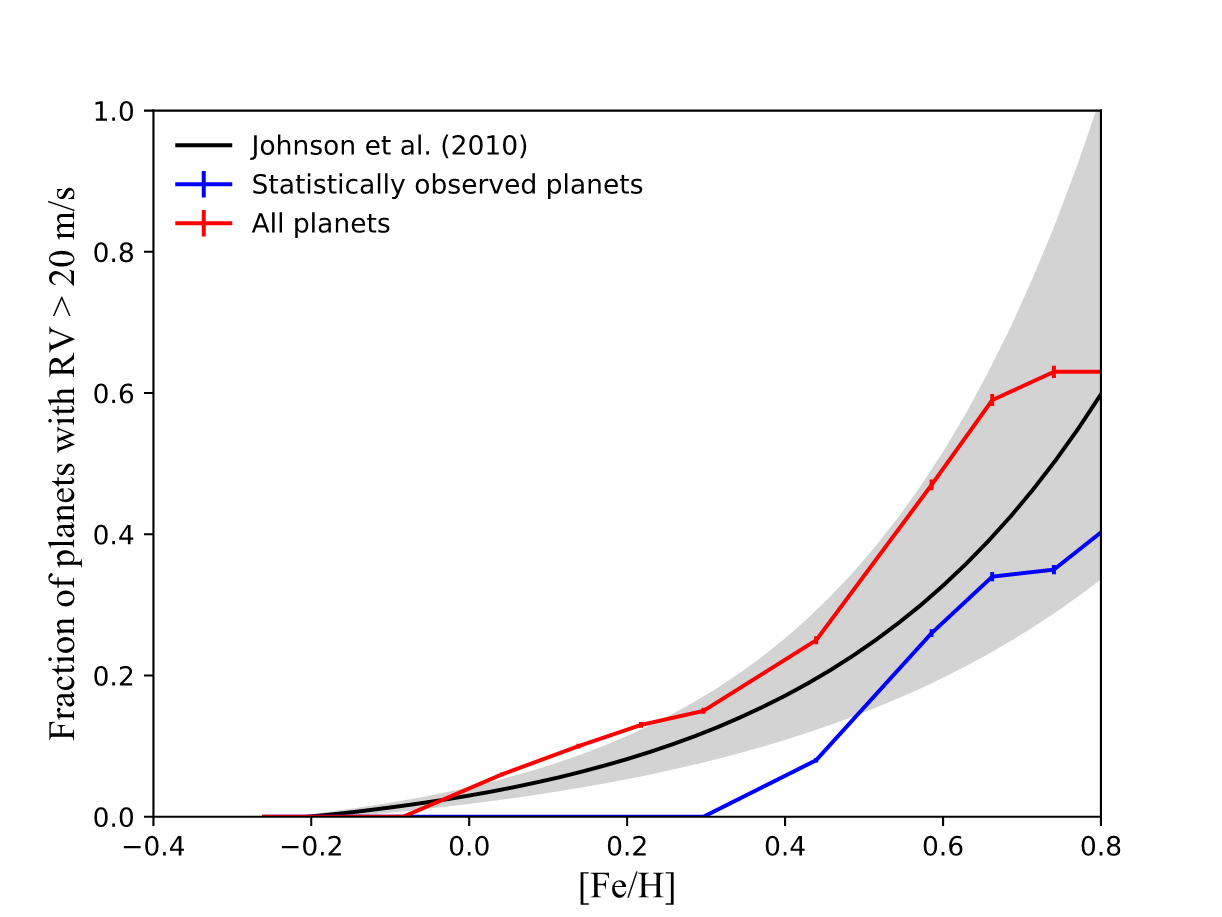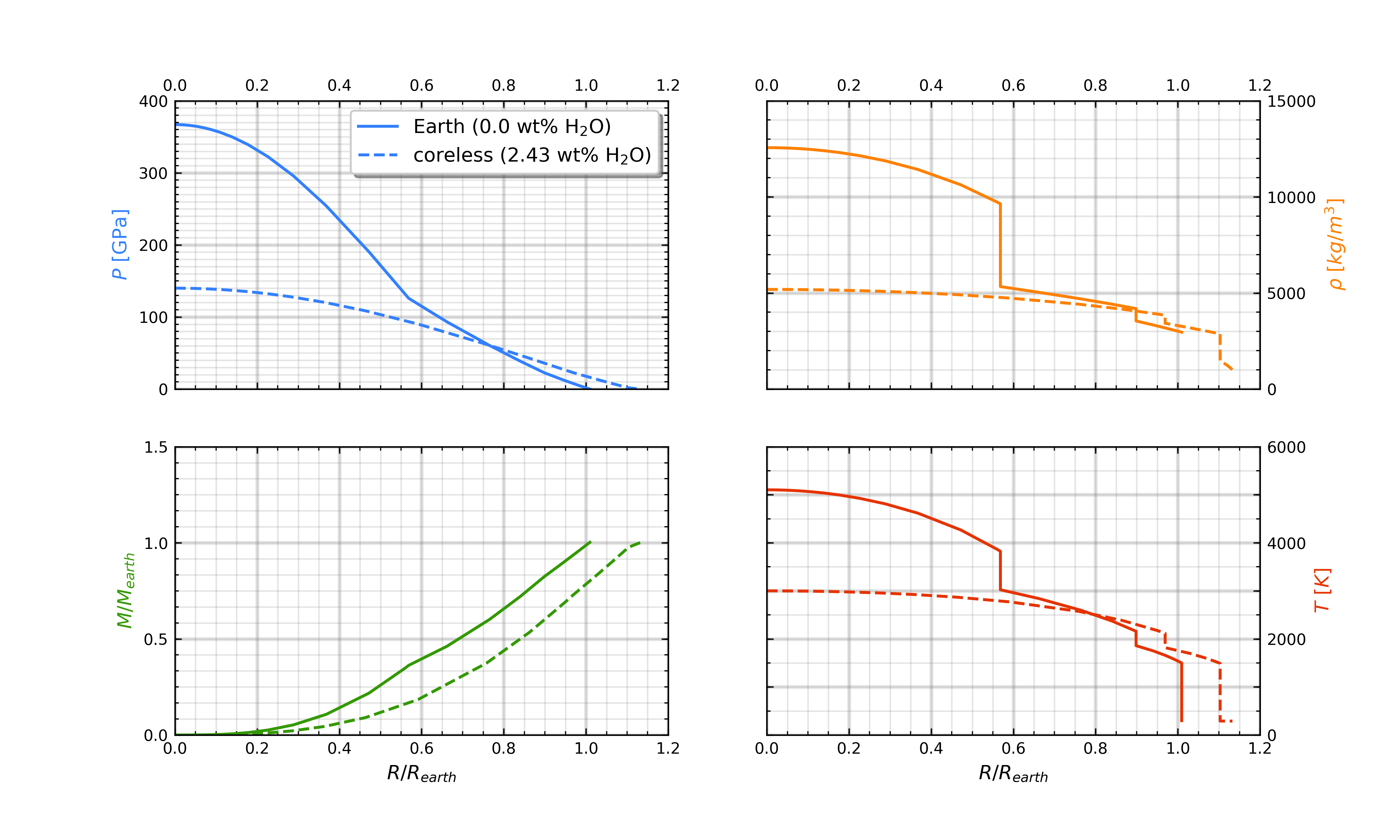Planetary systems formation models
We develop end-to-end planet formation and evolution models in order to compute the formation of planetary systems from a protoplanetary disk. We focus on formation around solar-type stars and around low-mass stars.
Planet formation around solar type stars: planetesimals versus pebbles
We have developed, with project 3.7, planetary system formation models in the context of planetesimal accretion. Our latest models include up to 100 planetary embryos, and can reproduce some key features of (extra)solar planetary systems. The results will be presented in a paper led by Alexandre Emsenhuber. The video below shows forming tracks of planetary systems, following the growth and orbital evolution of 100 planetary embryos in each system. The different colors correspond to different planetary types (gas giants in red, ice giants in blue, terrestrial planets in green), the horizontal lines indicating the peri- and apo-astron of each planets. The planets of the solar system are indicated by black dots.
Planetary system formation around solar-type stars
We have also worked with Natacha Brügger, on models in the framework of pebble accretion, and shown in
a recent paper, that our models reproduce the observed metallicity effect (larger occurrence rate of planets around metal-rich stars), as shown on the plot below, where red and blue line show the fraction of stars with an observable planet, to be compared with the observational data shown in grey.

Planet formation around low-mass stars
Recent surveys have discovered during the last years planets orbiting very low-mass stars, like proxima-b or Trappist-1. These studies were performed both in the framework of planetesimals and pebble accretion. In the case of planetesimal accretion, we have, with Remo Burn and project 3.7, adapted our models to the case of formation around a low-mass stars. On the video, the formation of such a system is shown. The horizontal axis shows the semi-major axis of the planets (initially 50 planetary embryos), the vertical axis showing their mass. The size of the center of the symbols representing planets is proportional to their core radius, and the size of the layer above the center is proportional to the thickness of the planets’ atmosphere. Finally, the color code represents the amount of ices in the planet. At some point on the video, the mean motion resonances appear on the plot, and, towards the end, the location of the Trappist-1 system in the diagram is shown.
Planetary system formation around a low mass star
We also developed models in the framework of pebble accretion with Gavin Coleman and Adrien Leleu. The following movie shows the formation of a trappist-1 like system by pebble accretion.
Trappist-1 like system formation by pebble accretion
Formation of coorbital planets
Still focussing on formation around low mass stars we have, with Adrien Leleu, Gavin Coleman and Sareh Ataiee, studied the formation of co-orbital planets. The video below shows the orbits of 6 planets forming around a low-mass star, where the planets are in 2 sets of triple coorbitals. The 2 panels show the system in the reference frame from one planet of the inner set of coorbitals (left), and from one planet of the outer set of coorbitals. Current planet positions are marked with ‘X’s and blue dots show their evolution over time. Remaining planetesimals are also included, and their stable orbits are shown as black dots (current position) and red dots (their evolution).
This soon to be published work shows that the stability of coorbital planets during their formation and evolution within a protoplanetary disc depends on the local disc conditions surrounding the planets, with certain conditions favouring the disruption of the coorbital system, and other conditions favouring their preservation. Overall the results show that coorbital planets have a high likelihood of existing in planetary systems, and should be observed in the near future.
Envelopes of low-mass planets in protoplanetary disks
We have performed, with Mark Hutchison, hydrodynamical simulations to study an important process controlling the delivery of material during planet formation: the replenishment of planetary envelopes, focussing on the effect of dust. This is done using a new state-of-the-art SPH algorithm presented in a recent paper. An exemple is provided on the following video where the 3D flow structure around a 15 Earth-mass planet embedded in a circumstellar disc at 0.25 au assuming an isothermal (left column) or adiabatic (right column) equation of state for the gas is shown.The gas density (coloured background) and velocity vectors (white arrows) show the flow structure for three cross-sectional slices through the planet’s location: (top) r-phi, (middle) r-z, and (bottom) phi-z. Once the flow structure has reached a quasi-steady state, we add six dust phases to see test how the equation of state (isothermal or adiabatic) affects the accretion of pebbles (< 5 cm) onto the planet.
Dynamics and compositional evolution of solids in protoplanetary disks
This project will be developed by a postdoc to be hired.
Collisions in the Solar System and beyond
This project is developed by Martin Jutzi and Harry Ballantine.
Using giant impact simulations, combining theoretical modelling and spacecraft observations, we constrain the conditions in the early Solar System, and develop general scaling laws for the outcome of collisions. An exemple, in the case of Saturn’s moons, is shown below an presented in a recent paper published in Nature Astronomy.
Water-rich planets: formation and structure
We have started developing, with Projects 1.5 and 2.4, models of water-rich planets, considering effects like the hydration of silicates, the consequences of chemical reactions between water and metals (that may lead to H2 production and modification of the mass-radius relation). These models will provide us with the evolution of the chemical bulk composition of low-mass planets and constitute the PhD of Oliver Shah, PhD student in co-supervision with Projects 2.4 and 1.5.
The plot below shows the first results computed using the code we have developed, in which an earth profile and a coreless planet with a 2.43 wt% water layer is computed and compared with Alibert 2014).

The chronology of Jupiter formation
Recently, new constraint have aroused on the chronology of Jupiter’s formation: Jupiter appeared to have spent a long time
(two millions years) at a mass between 20 and 50 Mearth. This surprisingly long timescale is difficult to reconcile with planet formation theory, as a planet of 20 Mearth is believed to accrete gas very rapidly. In this paper led by Yann Alibert, we have shown, with Projects 1.2, 1.4, 2.3, 2.4 and 3.7, that this chronology is only possible if Jupiter was formed by the accretion of both planetesimals and pebbles. In this case, the formation of Jupiter occurs in three phases. During the first phase, pebbles are accreted to build-up Jupiter’s core. During this phase, primordial large planetesimals (around 100km in size) collide and fragment to form smaller size planetesimals. In the second phase, the pebbles cannot be accreted anymore (Jupiter reached the so-called pebble isolation mass), and small planetersimals (produced during the first phase) are accreted. Their accretion provides enough energy to delay gas accretion during 2 Myr, thus explaning the chronology of Jupiter’s formation. Finally, in the third phase, Jupiter accretes gas in a runaway mode.

See also Nature’s blog ‘behind the paper’, and Instagram accounts.

